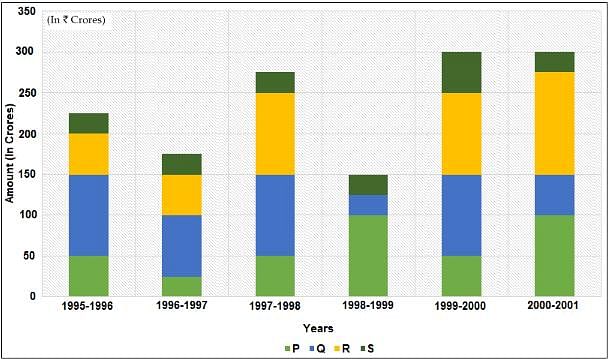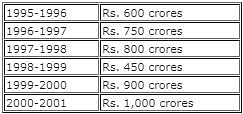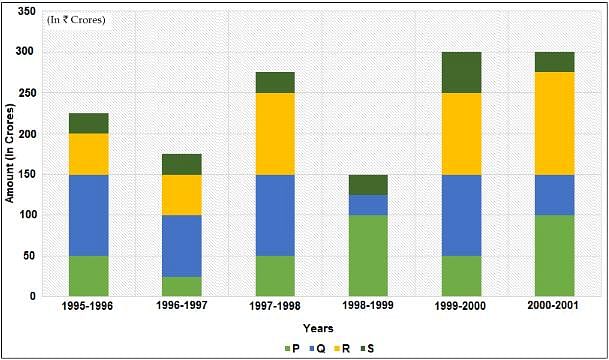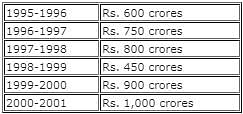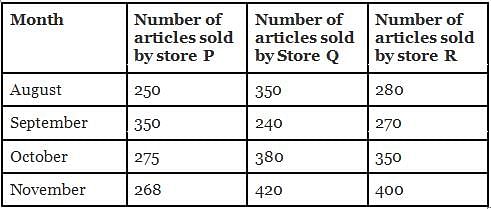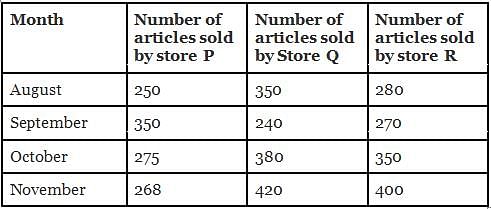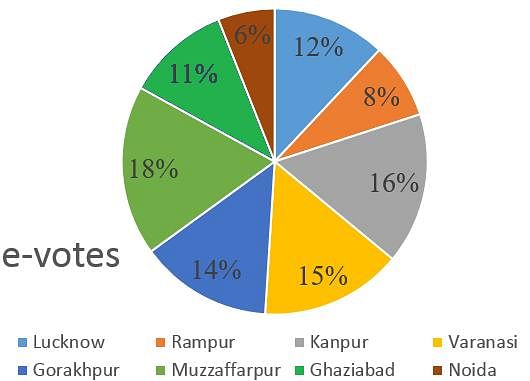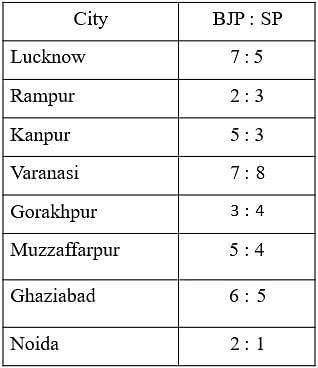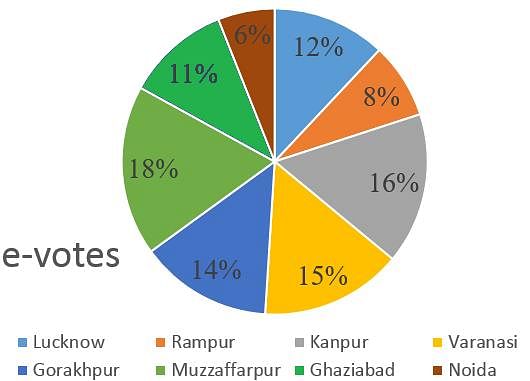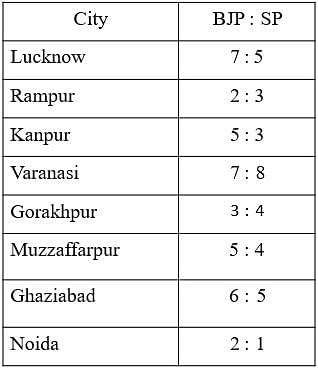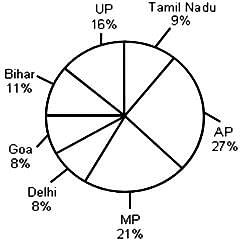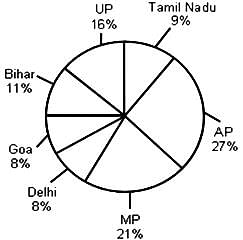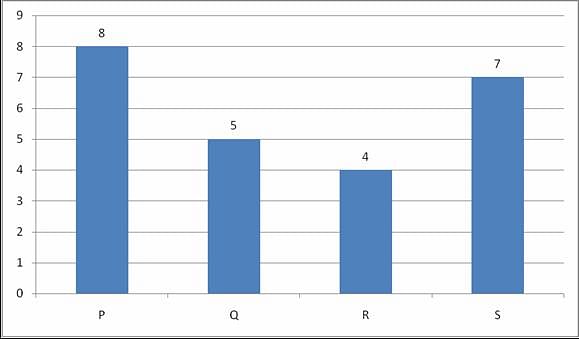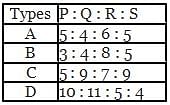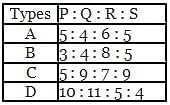This EduRev document offers 10 Multiple Choice Questions (MCQs) from the topic Mixed Graphs (Level - 1). These questions are of Level - 1 difficulty and will assist you in the preparation of CAT & other MBA exams. You can practice/attempt these CAT Multiple Choice Questions (MCQs) and check the explanations for a better understanding of the topic.
Question for Practice Questions Level 1: Mixed Graphs
Try yourself:Directions: Study the following stacked bar graph which represents the advertisement expenditure of a trading company from 1995 - 96 to 2000 - 01 on its products P, Q, R and S.

Note: Sales for the given years are as follows:

Profit = Sales - Advertising Expenditure
Q. The advertising expenditure of product S as a percentage of the advertising expenditure of P and R together is least in which of the following years?
Explanation
In 1995 - 96 = 25/100 = 1/4
In 1996 - 97 = 25/75 = 1/3
In 1998 - 99 = 25/100 = 1/4
In 1999 - 2000 = 50/150 = 1/3
From the results, the advertising expenditure of S as a percentage of advertising expenditure of P and R together was least in 1995 - 96 and 1998 - 99.
Report a problem
Question for Practice Questions Level 1: Mixed Graphs
Try yourself:Directions: Study the following stacked bar graph which represents the advertisement expenditure of a trading company from 1995 - 96 to 2000 - 01 on its products P, Q, R and S.

Note: Sales for the given years are as follows:

Profit = Sales - Advertising Expenditure
Q. If the ratio of sales of the products P, Q, R and S in the year 2000 - 01 is 2 : 5 : 1 : 2, then the profit of S is what percentage of the profit of Q in the same year?
Explanation
Sale of the products P, Q, R and S in 2000 - 01 are Rs. 200, Rs. 500, Rs. 100 and Rs. 200 crores, respectively.
Profit of Q = 500 - 50 = Rs. 450 crores
Profit of S = 200 - 25 = Rs. 175 crores
∴ Required percentage

= 4 × (5.55)%
= 38.89%
Report a problem
Question for Practice Questions Level 1: Mixed Graphs
Try yourself:Directions: The given table gives information about the number of articles sold by store P, Q and R from August to November and the profit earned by each store by selling each article. Answer the question that follows.


Q. The total articles sold by stores P and Q from August to October is what percent more than total articles sold by store R from August to October?
Explanation
Total number of articles sold by stores P and Q from August to October = 250 + 350 + 350 + 240 + 275 + 380 = 1845
Total number of articles sold by store R from August to October = 280 + 270 + 350 = 900
Required percent = (945 × 100)/900 = 105%
Report a problem
Question for Practice Questions Level 1: Mixed Graphs
Try yourself:Directions: The given table gives information about the number of articles sold by store P, Q and R from August to November and the profit earned by each store by selling each article. Answer the question that follows.


Q. What is the difference between the profit of all three stores in the month of September and the profit of stores Q and R in October from the sale of article?
Explanation
Profit of all three stores in the month of September = 270 × 350 + 240 × 278 + 270 × 328
= 94,500 + 66,720 + 88,560 = Rs. 2,49,780
Profit of stores Q and R in October = 278 × 380 + 350 × 328
= 1,05,640 + 1,14,800 = Rs. 2,20,440
Difference = 2,49,780 - 2,20,440 = Rs. 29,340
Report a problem
Question for Practice Questions Level 1: Mixed Graphs
Try yourself:Directions: In the recently concluded UP Elections, a total of 2,50,000 e-votes were casted from 8 different cities mentioned below in the pie-chart. The table shows the ratio of e-votes received by BJP to SP.


Q. What is the ratio of e-votes received by BJP in Lucknow to those in Noida?
Explanation
e-Votes received by BJP in Lucknow

e- Votes received by BJP in Noida

Required ratio = 175 : 100 = 7 : 4
Report a problem
Question for Practice Questions Level 1: Mixed Graphs
Try yourself:Directions: In the recently concluded UP Elections, a total of 2,50,000 e-votes were casted from 8 different cities mentioned below in the pie-chart. The table shows the ratio of e-votes received by BJP to SP.


Q. What is the ratio of the total number of e-votes cast to BJP in Kanpur and Varanasi to the total number of e-votes cast to SP in the same two cities?
Explanation
e-Votes cast to BJP in Kanpur and Varanasi

e-Votes cast to SP in Kanpur and Varanasi

Required ratio = 17 : 14
Report a problem
Question for Practice Questions Level 1: Mixed Graphs
Try yourself:Directions: The pie chart given below shows the percentage population of seven different states in a particular year. The table shows sex and literacy ratios. Based on the given information, answer the following question:

Total population of the given states = 32,76,000

Q. What is the ratio of the number of females in Tamil Nadu to that in Delhi?
Explanation
Report a problem
Question for Practice Questions Level 1: Mixed Graphs
Try yourself:Directions: The pie chart given below shows the percentage population of seven different states in a particular year. The table shows sex and literacy ratios. Based on the given information, answer the following question:

Total population of the given states = 32,76,000

Q. What was the total number of illiterate people in AP and MP?
Explanation
Total number illiterate people in AP and MP = ((7/9) × 27% + (4/5) × 21%) × 32,76,000 = (21 + 16.8) × 32,760 = 12,38,328
Report a problem
Question for Practice Questions Level 1: Mixed Graphs
Try yourself:Directions: Read the following information carefully to answer the question that follows.
Cost of different ingredients (in Rs./g) used in making food products:

Ratio of ingredients in each type of food products:

Total cost of food products = Rs. 15 (making charges per food product) + ingredients cost
Q. What is the total cost of 500 g of type A and 600 g of type B food products?
Explanation
Ingredient P used in 500 g of type A and 600 g of type B food products = (500 × 5/20) g + (600 × 3/20) g = (125 + 90) g = 215 g
Ingredient Q used in 500 g of type A and 600 g of type B food products = (500 × 4/20) g + (600 × 4/20) g = 220 g
Ingredient R used in 500 g of type A and 600 g of type B food products = (500 × 6/20) g + (600 × 8/20) g = 390 g
Ingredient S used in 500 g of type A and 600 g of type B food products = (500 × 5/20) g + (600 × 5/20) g = 275 g
Total cost = Rs. (30 + 215 × 8 + 220 × 5 + 390 × 4 + 275 × 7) = Rs. 6335
Report a problem
Question for Practice Questions Level 1: Mixed Graphs
Try yourself:Directions: Read the following information carefully to answer the question that follows.
Cost of different ingredients (in Rs./g) used in making food products:

Ratio of ingredients in each type of food products:

Total cost of food products = Rs. 15 (making charges per food product) + ingredients cost
Q. What is the total cost of ingredients in 600 g food products of type B and 1200 g food of type C?
Explanation
Ingredient P used in 600 g food products of type B and 1200 g food of type C = (3 × 600/20 + 5 × 1200/30) g = 290 g
Ingredient Q used in 600 g food products of type B and 1200 g food of type C = (4 × 600/20 + 9 × 1200/30) g = 480 g
Ingredient R used in 600 g food products of type B and 1200 g food of type C = (8 × 600/20 + 7 × 1200/30) g = 520 g
Ingredient S used in 600 g food products of type B and 1200 g food of type C = (5 × 600/20 + 9 × 1200/30) g = 510 g
Total cost = Rs. (290 × 8 + 480 × 5 + 520 × 4 + 510 × 7) = Rs. 10370
Thus, answer option 2 is correct.
Report a problem
